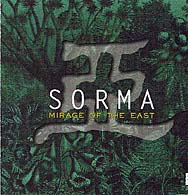Sorma: Pacific Moon CHCB-10014 compact disc, produced by Takaharu Kobayashi and Sorma. 1999. |
|
Sorma works with the Pacific Moon label. A Pacific moon title produced by Kiyoshi Yoshida, "Asian Drums," is also reviewed in this issue of EOL. Sorma formed in 1995 and has rotating a membership that focuses on Number One (Yoichi Shimada) and three other performers: Number Two (Eijiro Shimada), Number Three (Yasufumi Yamashita), and Number Seven (Rikiya Yamashita). Each performer is given a number, perhaps to lend an air of mystery or anonymity which holds a certain cachet in some dance circles. However, each performer is also clearly listed by name and number in the liner notes. While every Japanese performer's name is listed in full, only first names are given for Indian and Mongolian performers; this is perhaps understandable in the case of Mongolia, at least until recently, leaving them effectively anonymous. Listing of sampled performer names taps into old, but not unimportant, debates of appropriation; in this instance, they seemed to have gone only halfway in addressing that issue. Japanese composers involved in Sorma traveled through parts of Asia, primarily Bali, India, and Mongolia, and recorded music during their journeys. Their press release stresses the "authentic spontaneity" of the contexts surrounding these recordings, stating "without a coordinator they took portable DAT recorders and went to the mountains of India, the prairie of Mongolia, and villages in Bali. They made friends with the residents, collecting their sounds while singing and dancing with them." Naturally, such statements work to make Sorma's use of Japanese and Western instruments and musical theories invisible, while exoticizing other musics. The press release also states how local performers were amazed by and pleased with the "mysterious" transformation of their music upon hearing Sorma’s final edited result. |
|
"Gumbalo" opening |
Traditional Japanese instruments, such as koto, fue, and shakuhachi, are used on some tracks. Track one (Audio 1) presents koto, fue, synthesized percussion, electric bass, and Indian folk singing. |
"Satie's Sari," internal excerpt |
Others tracks feature Indian instruments such as sitar and tabla, and Western instruments like piano and guitar. Track 5 (Audio 2), "Satie's Sari," is a remake of a previous song from Sorma's "Illusions" release. |
"Holly Mountain" opening |
All voices heard on this disc are samples of either North Indian folk music (heard in Audio 1) or Mongolian urtin duu. "Holly Mountain" (Audio 3) is an example of Mongolian singing accompanied by guitar and various synthesized tracks. |
"Aouma" opening |
Balinese gamelan is heard in the mix of "Aouma," (Audio 4), but no listing is given for the performers, although the sampled sound of insects in Bali is given credit on track 9. |
| As with "Asian Drums," this is a well-produced album that joins a large stock of recordings that combine traditional music with more modern technologies and sounds. | |
| Paul
Jong-Chul Yoon ...is a graduate student at Columbia University. His current work focuses on the Korean American community in Flushing, Queens. Past work has addressed issues of Asian American and Japanese American identity with a specific focus on the New York City taiko group Soh Daiko. |
|
